
by California Casualty | Educators, Nurses |
The working life of a school nurse has always been hectic – treating schoolyard injuries, doing health screenings, helping address mental health issues and so much more. And then Covid arrived, making the “old days” seem quaint.
School nurses’ response to the pandemic has underscored what we already know: they are health care superstars. In these last 12 months of disruption and crisis, school nurses have heroically taken on even more responsibility, served as public health advisors for school boards and administrators, and kept students and communities safe through the pandemic.
Here are some lessons we learned about the role of the school nurse in 2021.
Nurses are critical in safe reopening
As districts across the country continue reopening with varying phases, plans, and protocols, nurses are critical to their doing so safely. As the frontline of student safety, they’re on point for best practices for reopening policies, temperature testing, screening, mask distribution, health and safety guidelines, ongoing monitoring, and more.
They are a pillar of public health
Nurses are the health experts that school communities look to for guidance. They answer questions from parents, staff, and students. Nurses have always been health educators, but especially now, that role is so important in disseminating local health policies and guidelines, training staff on COVID-19 infection control, helping staff do self-care, and educating the wider community. Many are involved in wider public health initiatives or organizations.
Their jobs are complex
While COVID-19 prevention and mitigation efforts are at the top of their list, nurses still must attend to all the other illnesses, injuries and student concerns that they always have. School nurses are a lifeline for students with chronic conditions, often procuring their equipment and medications, drafting student health plans, and helping them manage their conditions. They also reach out to at-risk students and help with deliveries (such as medication and food) to those in need. They often serve hundreds of students, all with different and changing needs.
Nurses’ expertise is unmatched
More than any other role in the education system, nurses are the health and wellness linchpin. Their training and skills go beyond everyday health care. They must have great listening and communication skills, be life-long learners, be empathetic and caring, think quickly, and have great judgment and problem-solving skills. They’re consummate team players, using interpersonal skills, professionalism, and attention to detail. And increasingly so, they must be knowledgeable about new public health threats and developments – connecting the dots between local and national trends.
They’re important to a student’s overall success
Good health is foundational to a student’s ability to thrive. When they’re healthy, they’re better able to excel in their studies, develop their interests, pursue their dreams and build relationships. Nurses support student’s success by providing care and support – to students’ physical, emotional, mental health as well as social health needs. They provide assessment, intervention, and follow-up for all students.
They can deliver care anywhere
School nurses have always provided care and support in person, but now they’re doing it remotely – or using a combo of the two. They have had to “go virtual” basically overnight and work to ensure kids didn’t face a gap in care. They’ve had to figure out fixes for students who need ongoing care but maybe don’t have digital access. They have to make the call on what care can be done remotely and what requires in-person attention. Having the right tools and the continued support of their districts and administrators remains important as ever.
Going forward, these important lessons will inform how the school nurse’s role evolves. Being at the frontlines of how COVID-19 has affected communities, schools, and students, the voice of the nurse will be critical in shaping health care and public health for decades to come. Thank you, school nurses, for all that you do to keep your schools and communities healthy and safe!
This article is furnished by California Casualty, providing auto and home insurance to educators, law enforcement officers, firefighters, and nurses. Get a quote at 1.866.704.8614 or www.calcas.com.
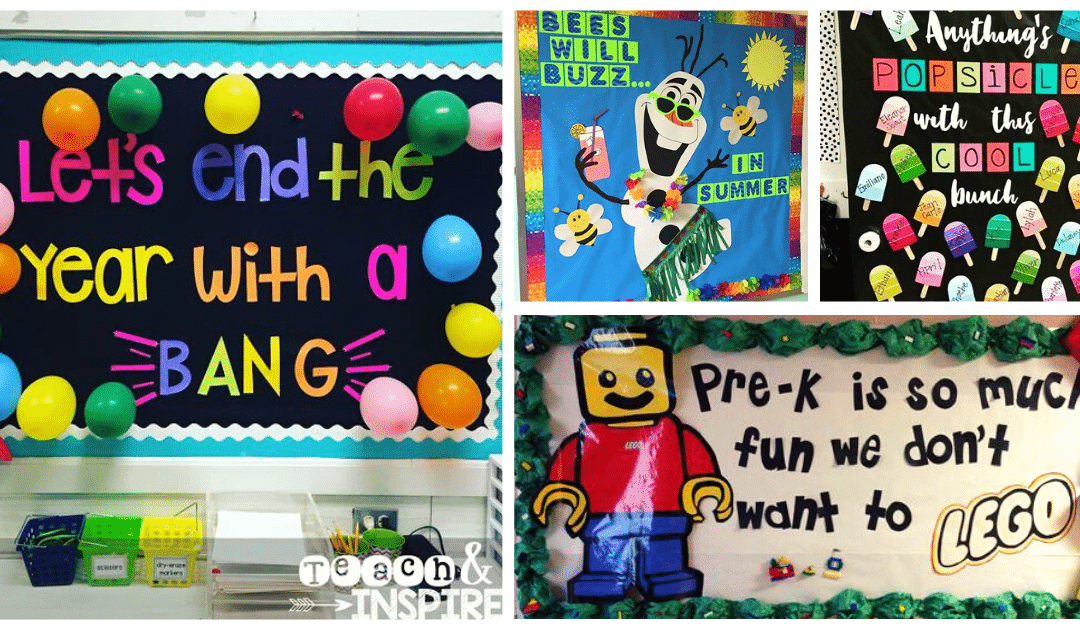
by California Casualty | Educators |
The end of the school year a great time to celebrate your students, their accomplishments and get them looking forward to sweet summertime! And what better way to do that than a fun bulletin board?
Check out our favorite end-of-the-year bulletin boards below.
1. We’re So Bright…
You can have so much fun with this one! Have your students model their best poses and faces to make for the cutest end-of-the-year bulletin board in school.

2. When I Grow Up I Want To Be:
You can give them these photos on the last day of school so they can look back on it when they do start their careers and see if it’s what they wanted to be when they were little.

3. End the Year With a BANG!
Use balloons to count down to summer! Have students take turns popping balloons each morning until there are none left on your last day.

4. All the Feels About Leaving
Because who doesn’t love emojis? You kids could even make their own using paper plates.

5. It’s O-FISH-ALLY Summer
Each student gets their own fish to decorate!
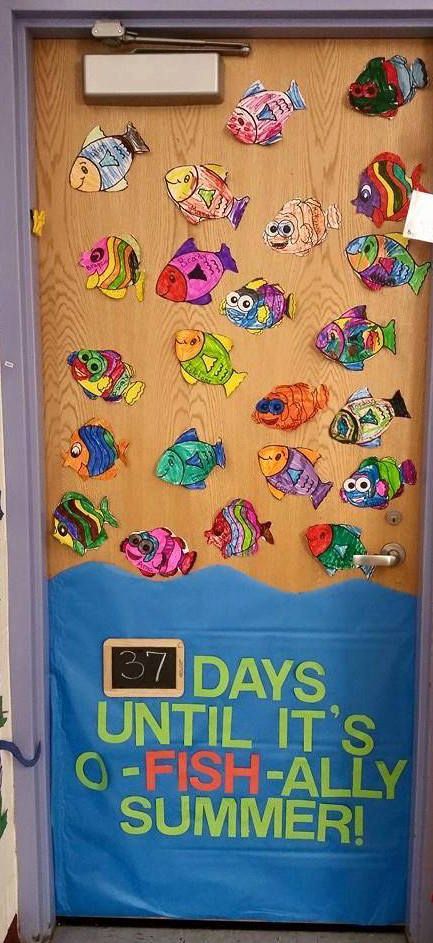
6. The Friendship Board
It’s always a fun day in class when students have permission to get messy on PURPOSE 😉

7. Where will you go?
Such a creative way to decorate a door with a long window!
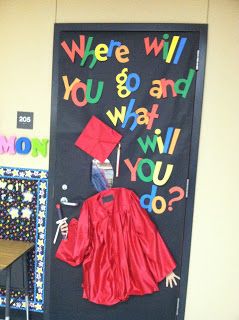
8. Silhouette Autobiographies
Such a fun idea that can be used in a multitude of ways autobiographies, their favorite school memory, what they’ve learned, what they are looking forward to about their next grade, etc.

9. Polaroid or Instagram Door!
Fill with photos of your class, books that you’ve read, science projects, favorite sight words, class pets, memories from the year, etc. You can use the polaroid theme, or make them into squares like Instagram 🙂

10. Surfin’ Into Summer
Because who doesn’t love a fun summer-themed bulletin board to celebrate the end of the school year?

11. Going Out With a Boom
Chicka Chicka Boom Boom, enough said.

12. Summer Bucket List
A fun writing prompt and bulletin board where kids can design their own buckets!

13. Anything’s Popsicle
Popsicles using paint samples? Such a cheap and easy idea!
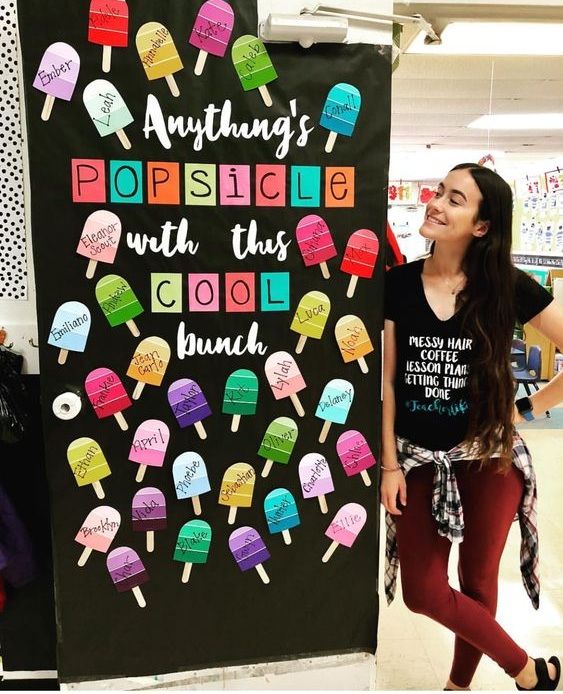
13. In Summer…
Because who doesn’t love Olaf?
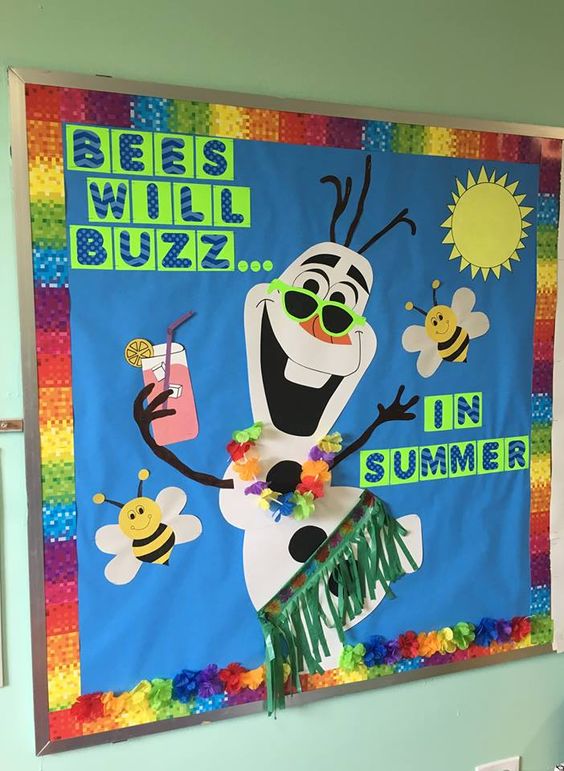
15. A TPT Summer
For those teachers who like to have an aesthetic classroom

16. High Five to a Great Year!
Have students trace their hands, put their names in the middle, and then decorate them! This is such a great craft that students can take home for their parents on the last day of school.
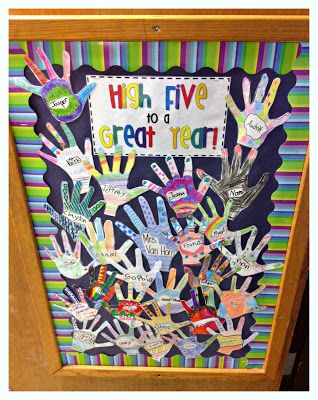
17. It’s Almost Time to Pack, Man
Bulletin board puns are the best puns

19. Don’t BLOW IT This Summer
Such a fun way to incorporate staff or student photos into your bulletin board.

20. Choppin’ Into First Grade
Use student photos, their names, or have them create their own fish to put inside the alligator’s mouth!
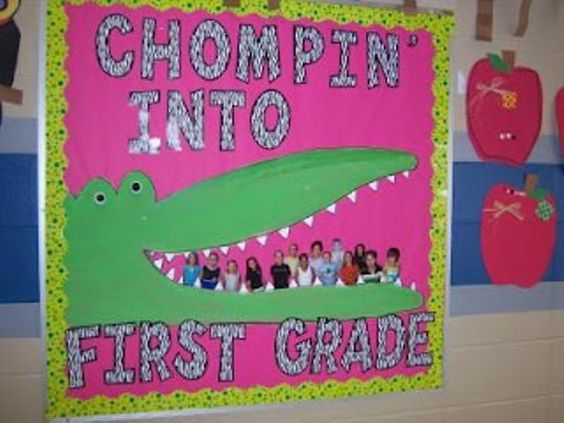
21. Countdown to Summer Chain
Remove a chain link each day as you get closer to summer. For even more fun write down activities or quotes on the chain links and as you remove them perform/read whatever is on it.

22. This Year Was Sweet
A fun bulletin board that encourages students to

23. Harry Potter-Themed
Mischief has been managed!
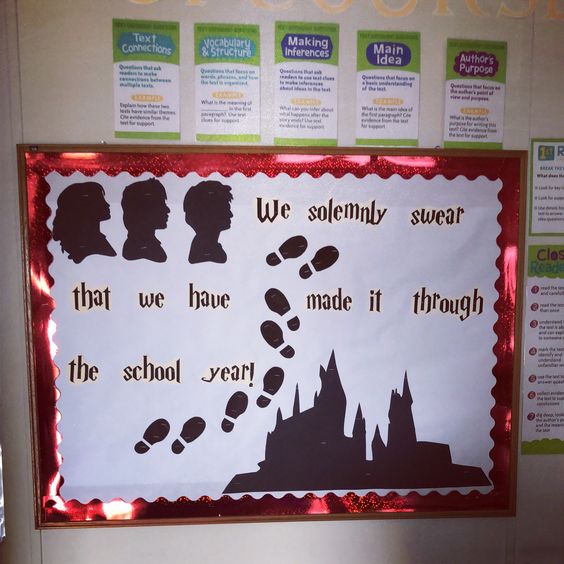
24. I’m Looking Forward To…
A fun writing prompt activity that lets students write about what they are looking forward to this summer.
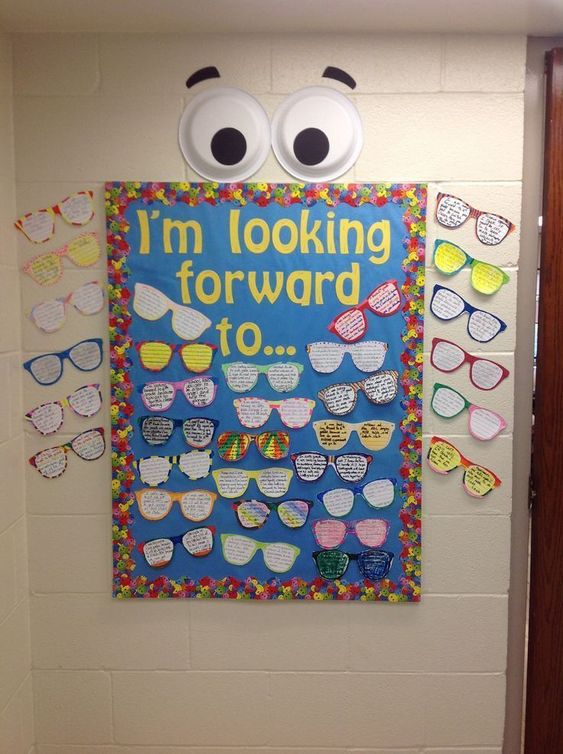
25. Stay on Target
A fun and interactive bulletin board that you can switch up the style and keep the concept!
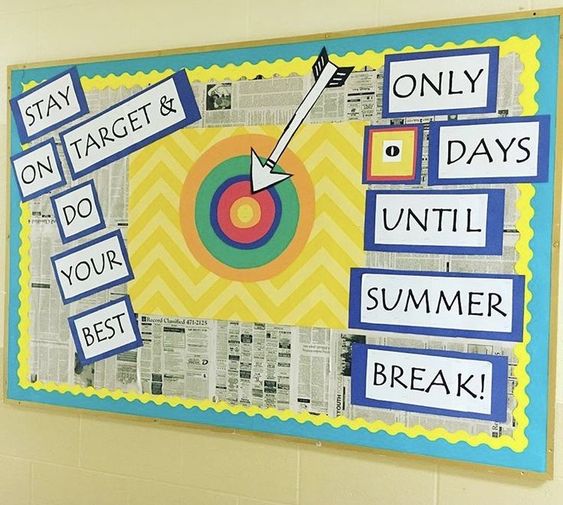
26. The ABC’s of the Year
Give each student a letter of the alphabet to create a drawing from something they learned that starts or contains their letter.
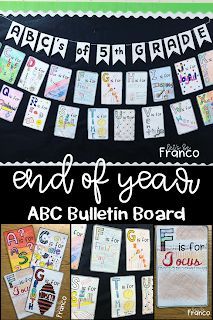
27. We Don’t Want to LEGO
Remember how we said bulletin board puns are the best?

28. Smart Cookies!
Who wouldn’t want to have a giant bulletin board full of cute little cookies to end the year?

For more End of the Year Bulletin Boards visit our “Teachers: End of the Year Bulletin Board Ideas” board on Pinterest!
Don’t forget to give us a follow at California Casualty to stay up to date on every new idea we discover! Scan our Pincode with your Pinterest camera to follow:

This article is furnished by California Casualty, providing auto and home insurance to educators, law enforcement officers, firefighters, and nurses. California Casualty does not own any of the photos in this post, all are sources by to their original owners. Get a quote at 1.866.704.8614 or www.calcas.com.

by California Casualty | Homeowners Insurance Info |
Updated landscaping touches can make your address more appealing to you, your neighbors and/or your potential new buyers. In fact, real estate experts say that nice curb appeal can add 14% resell value and help your home sell six times faster.
As the saying goes, “You only have one chance to make a first impression.” So whether you’re selling your house or simply ready to add value to your current home, we suggest you get out the shovel and think outside the box.
Here are some slow but steady changes you can make to make a beautiful space outside your front door.
Start by Mapping Out Your Space
Careful planning will keep you on-task and on-budget throughout the landscaping process. First, sketch a rough design of your yard, drawing in what you think might work well, like paths, gardens, and trees. You could also use a tool like Gardena Garden Planner to visualize your space online.
This is a great time to gather ideas on how you get the most out of your outdoor areas. Can you capitalize on great views, sunrises/sunsets, or extend your current indoor space to the great outdoors? Bonus points for creative solutions that provide options for more outdoor living.

Deck, Concrete, or Pavers
A large outdoor space for extra seating, eating, or entertaining is on the wishlist of many homeowners. How you approach the construction of such a feature depends on the slope of your yard, the weather in your area, the size of your space, your preference for certain materials, and your budget. You will want to include the space on your plan and then heavily research your options to get the most bang for your buck.
Choosing the Right Path
Paths that help you, your family (including your fur babies), friends, and neighbors navigate your new outdoor oasis are also a must. Consider how people will enter the area (back door, side gate, etc.) and meander through the space as you decide where your paths should go. And as you choose the materials for your pathways, remember crushed gravel sticks to paws and little ones often trip or stub their toes on uneven pavers.
Time to Revisit Your Budget
Now that you have a plan in place, it’s time to cross-reference your wish list with your determined project budget. Hardscapes such as pavers, stones, and rocks are more expensive, so get a feel for how much you can allocate to these areas as indicated on your plan. Trees are another element that can quickly use up your earmarked funds. Here’s when you prioritize your needs, wants, and must-haves, and then refine your design to make your money go further.
Love Your Lawn, Don’t Just Live With It
You will want a lawn that takes less maintenance to thrive; giving you more time to enjoy the space you’re creating. Not every kind of grass will work in your climate. Do some research, and plan accordingly. If you live in a hot area, a drought-resistant variety like Bermuda grass would be better than Kentucky bluegrass, which does better in the cold.
How Will Your Garden Grow
Most importantly, know your planting zone. You will save a lot of money, time, and headache if you choose plants that are hardy for your area based on your planting zone. Then create six to eight-foot deeps garden beds that follow a general rule of 50% evergreens, 25% deciduous (or flowering) shrubs, and 25% perennials. Include a mix of plants that bloom at different times and there will always be something to admire! Sufficient spacing between each plant will also ensure that your garden continues to grow beautifully for years to come.
Be sure to plant your garden far enough away from the exterior your home to give room for upkeep, protect the façade and keep unwanted pests from using the garden as a highway into your home.
Laying down a two to four-inch layer of mulch can help combat weeds and keep your plants’ roots warm and well-fed. Avoid mulch around shrubbery or other plants with roots close to the surface, or they will be smothered rather than provided for.
Trees
Trees provide great shade, beauty, and curb appeal. Plan their placement carefully. Root systems, preference for particular soil conditions, and size at maturity must be top of mind when deciding on trees in your landscape. Study the impact your chosen specimens will have on the areas you intend to plant them before you buy. For instance, pine trees will shed needles, change the acidity of the soil around them (impacting any plants nearby) and not allow for grass to grow under their branches.
With your space mapped, your budget itemized and your plantings identified, doing a landscape update yourself can be really rewarding now and for years to come. If you’re not the DIY type or still unsure as to how to tackle your curb appeal, hiring landscape professionals is another viable option. Either way, an updated curb appeal could lift your spirits and your home’s value. So dig in!
This article is furnished by California Casualty, providing auto and home insurance to educators, law enforcement officers, firefighters, and nurses. Get a quote at 1.866.704.8614 or www.calcas.com.
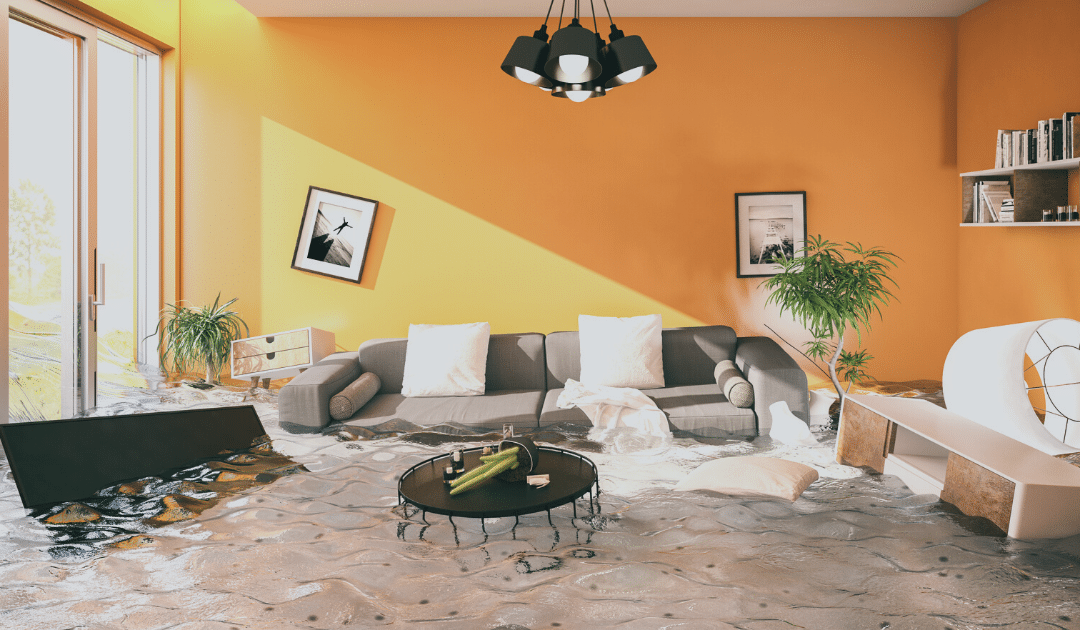
by California Casualty | Homeowners Insurance Info |
For some areas of the U.S., spring showers mean rising water, and rising water means the potential for flooding. While many mortgage companies require flood insurance in certain flood-prone areas, Mother Nature’s fear tactics remind us of the benefits and peace of mind this special coverage provides.
Floods are one of the most common and dangerous natural disasters in the US. You know that your home is protected thanks to Flood Insurance, but if you live in a flood-prone zone, you also need to have a plan in place for the safety of you and your family.
Here’s a quick list of what you can do should your home floods:
Take a Moment
Seeing your home underwater and your belongings saturated is an overwhelming and stressful event. You have to breathe and grieve as you assess the situation. The road ahead will be hard, but you will make it through.
Think Safety First
If you’ve left and returned, before setting foot in your home, walk around the outside of your building and inspect for damage to the exterior to make sure you aren’t at risk of a collapse while you’re inside.
Immediately call you’re the utility company if they are not in the area and you suspect damage has occurred that needs their attention.
Water and electricity don’t mix. Turn your main breaker off and flip the individual fuse switches into the off position. You may need a qualified electrician to inspect, clean, and dry the box before power can be turned back on again.
Get the Right Gear
Stagnant water can carry bacteria along with more obvious chemical contaminants, sewage, garbage, and debris. Plus, water-logged areas can have mold already starting to form. Use rubber boots and waders with water-tight gloves to make sure you aren’t exposed to these potential dangers. And don’t touch your face once you’ve started to clean up.
Call Your Insurance Company
Call your flood insurance provider. They will begin the claims process and schedule an adjuster to visit your home. Depending on your situation, FEMA (1.800.621.3362) may also have free help available.
Document Everything
Collect video evidence of how your home was hit. Go into each room, capturing full images of any and all damage. Pay special attention to the walls, flooring, appliances, and other expensive items that may have been made unusable.
Collect any paperwork that you need to share with the adjuster/insurance agent. Use your phone to take pictures of any paperwork if you don’t have a way to make photocopies. Be sure to keep a file with the date, times, names, and details of any conversations.
Tackle Cleanup
- Ventilate the area by opening all doors, windows, cabinets, and drawers
- Don’t plug anything in unless it has been deemed safe by an electrician
- Check with your insurance provider if you can begin repairs.
- If you’ve got the all-clear, begin by removing any standing water.
- Use a dehumidifier and fans to remove as much moisture as possible.
- Move any furniture and rugs that weren’t too badly damaged to your yard and let them sit under the sun directly.
- Remove drywall and insulation, carpets and padding, upholstered furniture, window coverings, and any other household items that cannot be adequately cleaned/sanitized.
- Throw out any unsealed food and/or any food exposed to floodwater
Be Sure to Document All Items Before Discarding Them
You could also use a third-party cleanup crew, allowing a team of professionals to do the hardest work for you. Check and see if your insurance provider will cover the costs of this.
Mitigate the Mold
Mold can develop in a very short time, and exposure to it can be dangerous in the long term. If you come across any while inspecting your home, it needs to be treated immediately. This can be done by mixing a cup of bleach with a gallon of water and scrubbing any spores. While disinfecting, wipe down any countertops and appliances that were exposed to water.
Start the Rebuilding Process
Before you determine which contractor to choose, get multiple bids. You will want to work with a contractor you can trust. Check their online reviews. Research their experience and project history. Check if they are licensed and bonded.
Be Sure to Keep All of Your Receipts.
Flooding can be a terrible tragedy to experience. With these tools and knowledge, you can be prepared to keep your home and family safe when disaster strikes.
For more tips on what to do after a natural disaster, or how to prepare for a flood, click here.
This article is furnished by California Casualty, providing auto and home insurance to educators, law enforcement officers, firefighters, and nurses. Get a quote at 1.866.704.8614 or www.calcas.com.
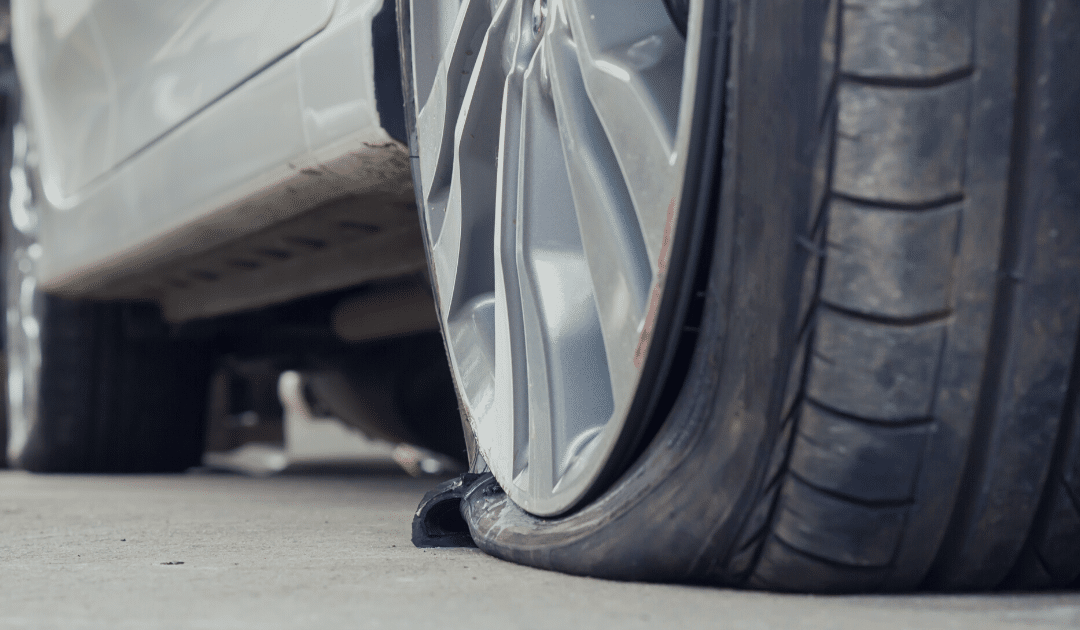
by California Casualty | Auto Insurance Info |
A tire blowout is a rapid loss of air that causes your vehicle to lose control. It’s a dangerous surprise that can happen anytime your car is in motion. If you are driving down the road and suddenly hear a loud POP or THUD and feel your car begin to jerk or pull to the side, odds are you have just experienced a blowout.
Tire blowouts can be frightening, especially for young or inexperienced drivers, and can cause you to feel like you’re losing control of your vehicle. Blowouts cause 78,000 crashes a year, so keeping your cool and knowing how to proceed after a blowout is vital.
Here’s what to do if a blowout happens to you.
Step 1: Don’t panic. The most important thing you can do during a blowout is to stay calm. Don’t try to immediately overcorrect or press on your brakes- this could cause you to lose even more control.
Step 2: Grip the steering wheel firmly. Keep both hands on the steering wheel and keep the car moving forward in a straight line. You may feel the need to try and steer off to the side of the road or overcorrect if it starts to fishtail- don’t. To avoid an accident keep the car as straight as you can.
Step 3: Tap your gas pedal. If you are trying to regain control of your vehicle, accelerating lightly will help you because you are keeping your forward momentum. Braking immediately will only cause the car to become harder to control and could lead to an accident. Gently press the gas pedal and adjust to how the car moves. Once you’ve regained full control, slowly remove your foot from the accelerator and let the car slow.
Step 4: Brake Slowly. When your speedometer reads 30mph, it’s safe to slowly begin braking. After you have slowed enough to begin hitting your breaks it is safe to steer the vehicle into the rightmost lane or shoulder of the road (if possible). Continue braking steadily until your car stops completely.
Step 5: Put on your hazards. Put it in park and turn on hazard lights or put out reflective triangles and collect yourself. If you are still in the middle of the road, you should exit your vehicle and get to safety- out of the way of a collision.
Step 6: Change your tire or call roadside assistance. If you can safely change your tire and there is no damage done to your rim, now is the time to do so. If you cannot safely change your tire or don’t have a spare call for roadside assistance.
How to Avoid a Future Blowout.
A tire blowout may happen due to a number of circumstances: underinflation, too much weight in the vehicle, hitting a pothole or other debris, and even over-wear.
To avoid a future blowout, try to miss potholes & debris- when you can safely do so- and make sure to maintain your tires. You can do this by routinely checking your tire pressure, monitoring your tires for wear and tear (even small cuts and other minor defects can lead to a blowout), and most importantly keeping up with getting new tires.
New tires can generally last you anywhere from 25,000 to 50,000 miles. You will want to refer to your owner’s manual for recommendations on what tires you can put on your vehicle and their lifespan. A great way to keep your tires in check is to monitor their tread. You can do this by using the quarter test. If you are unfamiliar with the quarter test, here’s how it works- place a quarter in the center of the tread (thickest part of the tire), with the head facing you, in a new tire the quarter will easily fit and you should be unable to see the hair on the top of the head. If the hair is partially visible, you should think about replacing the tires. If you can see the very top of the head, the tires need to be replaced right away.
What About Insurance?
So, are you covered if you experience a tire blowout? Your auto insurance policy may cover sudden or accidental damage to your tires, like a blowout, depending on your policy.
Before an unexpected blowout happens to you make sure you’re covered. Check with your auto insurance provider or call in to review your policy.
This article is furnished by California Casualty, providing auto and home insurance to educators, law enforcement officers, firefighters, and nurses. Get a quote at 1.866.704.8614 or www.calcas.com.


































